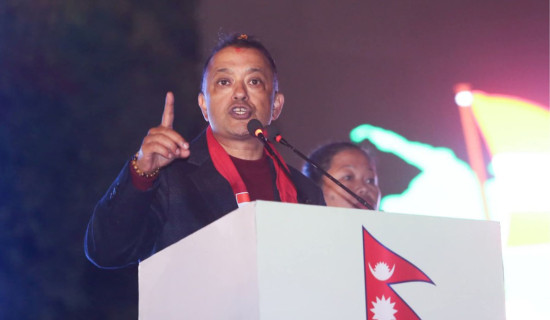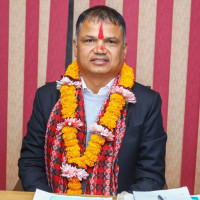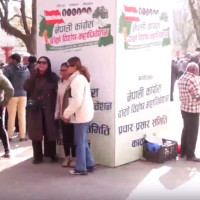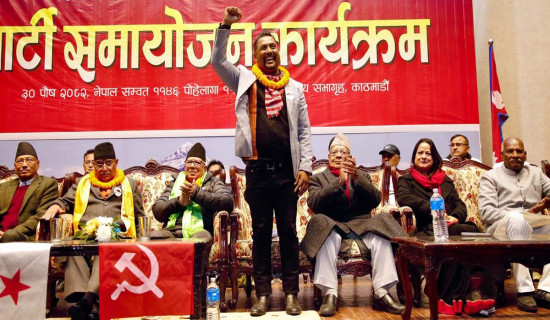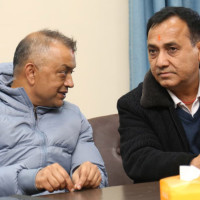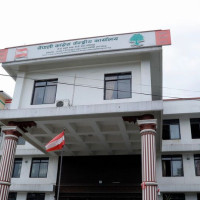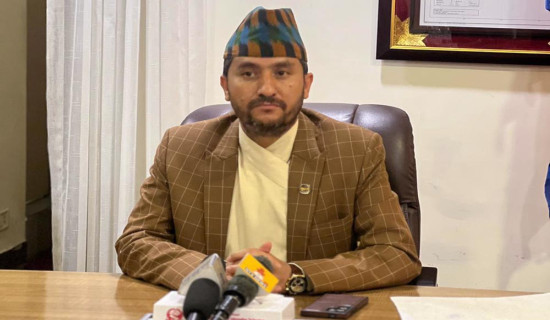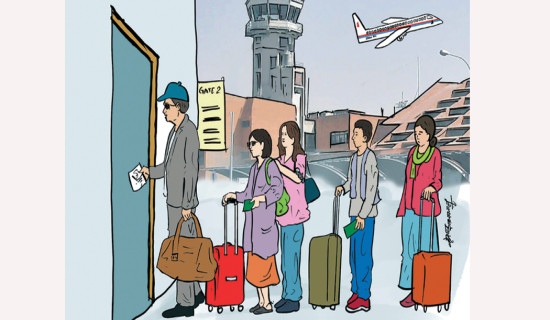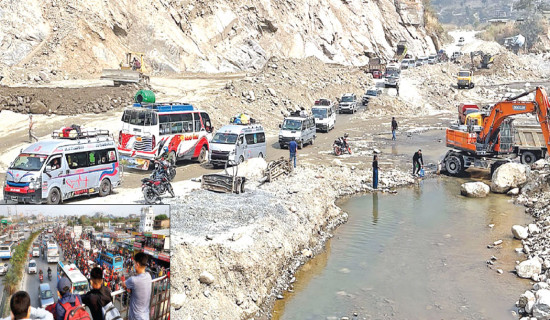- Thursday, 15 January 2026
Road fatalities taking a serious toll in Nepal
Kathmandu, Apr. 7: Road Traffic Accidents (RTAs) take more lives annually in Nepal than any other natural disasters listed by the government, including floods, landslides, and other disasters combined.
It is a somber reality that road accidents have become so common an occurrence, often with terrible loss of lives and crippling injuries every day.
On March 19, Tuesday, the country woke up to a shocking news about the death of nine individuals in Baglung bus accident. As many as 28 others were injured after the ill-fated bus en-route to Kathmandu from East Rukum met with an accident at Jaulepani, Nisikhola Rural Municipality-6, along the Mid-Hill Highway.
On March 30, Saturday morning, five members of a family died while another went missing as a taxi swerved off the road and plunged into the Trishuli River near Mugling. These are just a couple of cases from numerous incidents that rock the nation daily. Every day, there are news of deaths due to road accidents across the country.
According to the record of the Nepal Police Headquarters, a total of 1,303 persons had already been killed in different road accidents in the last seven months of the current fiscal year (from mid-July, 2023 to mid-February, 2024).
Within the same period, 3,643 passengers were seriously injured while 15,007 others sustained minor injuries.
Likewise, in the last five years (from 2019/20 to 2023/24), 12,542 individuals were killed in road accidents and 29,729 others sustained serious injuries. Adding up fatalities of last five years and seven months of the current fiscal, the total casualty figure amounts to a whopping 13,845.
According to the police, 2,540 persons died in the year 2019/20; 2,251 in 2020/21; 2,500 in 2021/22; 2,883 in 2022/23; and 2,368 in 2023/24.
Similarly, 5,646 persons were seriously injured in the year 2019/20; 4,615 in 2020/21; 6,448 in 2021/22; 7,282 in 2022/23; and 5,738 in 2023/24.
To compare, in the last five years, 1,500 individuals died in a total of 13,701 different natural disaster incidents, 3,966 were injured and 193 went missing. From July 17, 2022 to July 16, 2023 last year, 471 persons were killed in natural disaster incidents.
Whereas in the last seven months of the current fiscal (mid-July, 2023 to mid-February, 2024), 331 people were killed in total and 1,011 individuals were injured in different natural disasters like flood, thunderbolt, snakebite, landslide, animal incidents, fire, and earthquake. Five went missing during the period, according to bipadportal.gov.np record of the National Disaster Risk Reduction and Management Authority (NDRRMA). Of them, 155 killed in earthquake, 63 in fire, 28 in animal incidents, 27 in landslides, 20 in snake bites, 13 in thunderbolts, nine in high altitude sickness, nine in floods, five in non-natural disaster, one each in wind storm and boat capsize.
Back to road accidents, most of them took place in Madhes Province. Spokesperson of Nepal Police and Deputy Inspector General Bhim Prasad Dhakal said that 290 persons lost their lives in Madhes Province alone from mid-July, 2023 to mid-February, 2024.
Similarly, 261 persons died in Lumbini Province, 219 in Koshi Province, 173 in Bagmati Province, 114 in Sudurpaschim Province, 100 in Gandaki Province, 96 in Kathmandu Valley and 60 in Karnali Province. In the Kathmandu Valley, 117 died from mid-July, 2023 to March 13, 2024, according to the Traffic Police Office, Ramshahapath.
Kamal Pandey, road safety analyst, said, Nepal’s topography and weather make it difficult to build and maintain roads. Highways and rural roads meander around mountains, traverse cliffs, and follow narrow river gorges. Entire sections of Nepal’s arterial highways are in a permanent state of disrepair during the monsoon, like the landslide-prone Mugling-Narayanghat section.
Pandey said, “Well-constructed roads prevent accidents, but we have built ours ignoring technical and engineering aspects because new roads bring in votes, and maintenance doesn’t.”
All automobiles are subjected to mechanical inspection tests every six months, and those that fail are not allowed on the streets. But testing centres across the country are not functional as vehicles are certified based on manual (visual) inspection alone, he said. “We also have a lot of blind spots along our highways which makes driving difficult.”
Nepal’s motorable roads are classified into Strategic Road Networks, which include major highways under the purview of the Department of Roads, and Local Road Networks which are built and maintained by local governments, he said.
While the main highways have to follow engineering parameters to be approved for construction, local roads are built without adequate engineering, making them more dangerous.
“Local governments have taken charge of the construction of rural roads without fulfilling any of the required technical criteria,” said transport expert Madhu Sudan Acharya, adding that they are built without an understanding of road geometry or slope geology.
Pandey also agreed that rural road networks are not only sub-engineered but are being dug across fragile slopes by excavators at breakneck speed on a massive scale without adequate oversight. “Such roads have become death traps,” he warned.
Political interference and collusion between local contractors and their governments (in many cases the same person) to haphazardly build roads near private property has not helped matters.
Yet, driver negligence and poor vehicle maintenance play a bigger role in road accidents than climate, weather, or the way Nepal’s highways are constructed. Reckless driving on poorly built roads turn things deadly, he said.
A Ministry of Physical Infrastructure and Transport study has found that 76 per cent of road accidents are caused by drivers who do not follow traffic rules, or are speeding.
Acharya, who is one of the members of a seven-member task force of the 'Road Accident Study Committee' instituted by the Ministry of Physical Infrastructure and Transport led by former secretary Dhan Bahadur Tamang on January 14, 2024, said, “Nepal’s highways would be much safer if drivers were properly trained or if vehicles were better maintained. But they have little understanding of highway traffic rules, reading signage or basic mechanical knowledge.”
The Land Transportation Agency has also been lax in licensing and training drivers, especially those who seek to operate trucks, buses and long-haul four-wheelers. Fines for speeding and other traffic infractions, especially for two-wheelers, have not brought down the fatality rate. Motorcycles cause most of the road accidents in Kathmandu Valley and the Tarai. Of 23,597 road accidents that occurred last year, 19,511 motorcycle accidents, the highest among other road accidents by vehicles, took place.
Jeevan Kumar Shrestha, SSP and Spokesperson for the Kathmandu Valley Traffic Police Office, Ramshahapath, said, “Nepal’s existing road safety practices and protocols make it pretty clear that transport management authority is unable to govern properly, and needs a massive overhaul.”
8th leading cause of death
Road traffic accidents are the eighth leading cause of death worldwide, with projections that they will rise to the top five by 2030.
Countries in the WHO's Western Pacific and Southeast Asia Regions, in particular, account for more than half of all road traffic accident-related deaths worldwide. The Southeast Asia region's mortality rate is 18.5 per 100,000 people, with motorised two- and three-wheelers accounting for one-third of all deaths.
In Nepal, the population expanded by 15 per cent from 23.2 million in 2001 to 26.6 million in 2011, while vehicle registration increased by 325 per cent from 317,284 in fiscal year 2000–2001 to 1,348,995 in 2011–2012.
As of the current fiscal year 2024/25, according to the Traffic Police Office, there are 6,238,301 vehicles registered in Nepal. Similarly, the total distance of Nepal's present major and adjacent roads is 77,302.68 km, according to the traffic police office.
SSP Shrestha said that there are just 2,770 traffic police vacancies and of them, one traffic has the responsibility to watch 2,252.1 vehicles every day on roads.
Every day seven die, 83 get injured
SSP Shrestha said that on average, every day 65 traffic road accidents take place in different parts of the country, and on average, seven persons die and 83 get injured every day in Nepal.
Two-wheelers (motorcycles) account for over 80 per cent of these accidents, followed by light vehicles such as sedans, jeeps, and pickup vans. Despite the surge in road traffic accidents observed in recent years and the increased number of vehicles registered, few attempts have been made to assess the situation, explore the causes and find remedies to road accidents in Nepal, SSP Shrestha said.
The statistics presented by the Nepal Demographic and Health Survey (NDHS), 2022, showed the severity of the situation. Motorcycle passengers are most likely to die in road accidents, and the death toll is alarmingly high. According to the survey, there are 14 deaths per 100,000 people in
Nepal due to road accidents each year, resulting in approximately 4,060 deaths annually.
The inadequate state of road safety standards exacerbates the problem. According to NDHS report, only 25,000 kilometres out of 77,302.68 kilometres of road in Nepal meet appropriate road safety standards.
"This means that the majority of roads are subpar in terms of safety, posing a grave danger to all road users. To address this crisis, the government should prioritise the formulation and enactment of a comprehensive Road Safety Council Act," said expert Acharya.
This Act should establish a central authority, the Road Safety Council, responsible for overseeing and monitoring the daily road safety situation. At present, the responsibility for road safety is divided among multiple agencies, leading to inefficiencies and a lack of coherent action, said Acharya.
The Road Safety Council should be empowered to make and enforce road safety laws, streamlining the decision-making process and ensuring effective implementation, he added.



